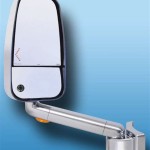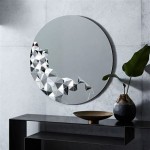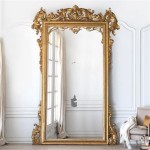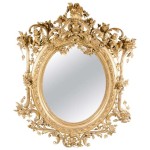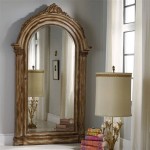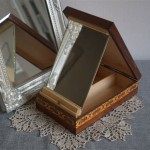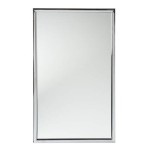Removing a Bathroom Mirror Glued to the Wall
Bathroom mirrors are often glued to the wall for a sleek and modern look. However, this can pose a challenge when it comes to removing them, particularly if the adhesive used was strong. Removing a glued mirror requires careful planning and execution to avoid damaging the wall or the mirror itself. This article provides a comprehensive guide on how to safely and effectively remove a bathroom mirror that is glued to the wall.
Assessing the Situation
Before attempting to remove the mirror, it is essential to assess the situation. Examine the mirror and the surrounding wall for any signs of damage or weakness. This includes checking the mirror's frame for any cracks or loose connections. Also, inspect the wall for any signs of water damage, mildew, or mold, which could make the removal process more challenging. Look for any existing holes or gaps in the wall around the mirror, which could indicate previous attempts at removal or indicate a less secure installation.
It's also important to note the type of adhesive used. If you are unsure, you can try to identify the adhesive by its appearance or by referring to any available product labels or instructions. Knowing the type of adhesive will guide you to the best tools and methods for removal.
Tools and Materials
To remove a glued bathroom mirror, you will need the following tools and materials:
- A putty knife or scraper
- A heat gun or hairdryer
- A soft cloth
- A bucket of warm water
- Dish soap (optional)
- A plastic scraper (optional)
- Safety glasses
- Gloves (optional)
- A ladder (if necessary)
The specific tools you need might vary depending on the type of adhesive used and the size and weight of the mirror. If you are unsure about the tools required or are concerned about causing damage, it is best to consult a professional.
Steps to Remove the Mirror
Once you have gathered all the necessary tools, follow these steps to remove the mirror:
- Prepare the area: Clear the area around the mirror to allow for ample working space. Any items near the mirror should be moved away to prevent them from being damaged.
- Loosen the adhesive: Apply heat to the adhesive using a heat gun or hairdryer. The heat will soften the adhesive and make it easier to remove. Be careful not to overheat the mirror, as this could cause it to crack or shatter.
- Insert the putty knife: Carefully insert a putty knife or scraper between the mirror and the wall. Work your way around the mirror, slowly and gently prizing it loose. If the adhesive is particularly stubborn, you can use a plastic scraper to help remove it.
- Remove the adhesive: Once the mirror is loose, use the putty knife or scraper to remove any remaining adhesive from the wall and the back of the mirror. If the adhesive is still difficult to remove, you can apply a small amount of dish soap to the area. Be sure to wipe away the soap residue afterwards.
- Clean the surface: After removing the mirror and the adhesive, clean the wall and the mirror with a soft cloth and warm water. This will remove any remaining debris or residue. You can also use a cleaning solution specifically designed for mirrors.
If you encounter any difficulties during the removal process or notice any signs of damage to the mirror or the wall, you should stop and seek professional assistance. Attempting to remove the mirror yourself could result in further damage and potentially injury.
Removing Excess Adhesive
Once the mirror is removed, you may find that some adhesive residue remains on the wall. If you are planning to hang another mirror or item on the wall, it is essential to remove this residue. You can use a variety of methods to remove adhesive residue, such as:
- Goo Gone: A commercially available adhesive remover that is safe for most surfaces. Apply it to the residue and allow it to sit for a few minutes before wiping it off. Always follow the manufacturer's instructions.
- Vinegar: White vinegar is a natural and effective adhesive remover. Soak a cloth in white vinegar and apply it to the adhesive residue. Allow it to sit for a few minutes before wiping it off.
- Heat: Similar to the initial removal process, you can apply heat to the adhesive residue with a heat gun or hairdryer. The heat will soften the adhesive and make it easier to remove. Be careful not to overheat the wall, as this could cause damage.
When removing adhesive residue, it is essential to be patient and work carefully to avoid damaging the wall. Always test any adhesive removal method in a discreet area before applying it to the entire surface.
Removing a glued bathroom mirror can be a challenging task, but with the right tools and techniques, it can be done safely and effectively. Remember to assess the situation before starting, use the appropriate tools and materials, and work carefully and patiently to avoid damaging the mirror or the wall. If you are unsure about any aspect of the removal process, consult a professional.

How To Remove A Mirror Glued The Wall Forbes Home

How To Remove A Bathroom Mirror Lowe S

How To Remove A Large Mirror That S Glued The Wall Emerging Home

How To Safely And Easily Remove A Large Bathroom Builder Mirror From The Wall Site Title

How To Remove A Wall Mirror 11 Steps With Pictures Wikihow

How To Safely And Easily Remove A Large Bathroom Builder Mirror From The Wall Site Title

Removing A Glued On Mirror From Wall

How To Remove A Wall Mirror 11 Steps With Pictures Wikihow

How To Remove Mirror Off Wallsafely

How To Remove A Wall Mirror Diy Weekend Project Bedroom Black

